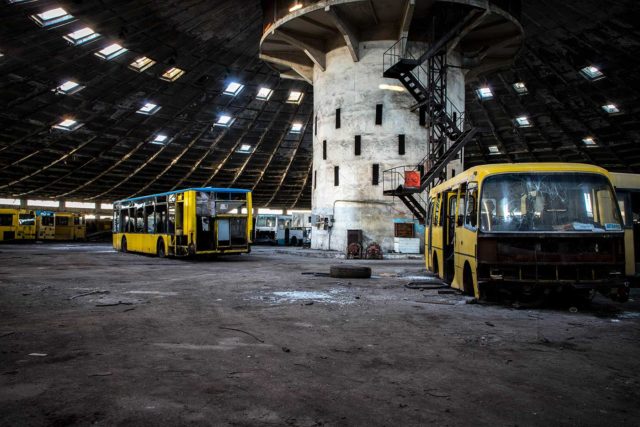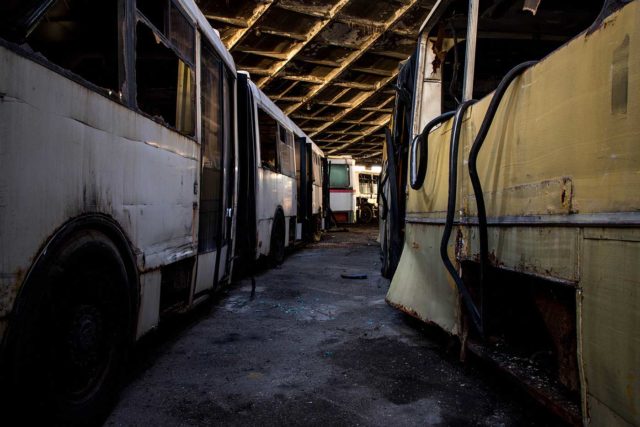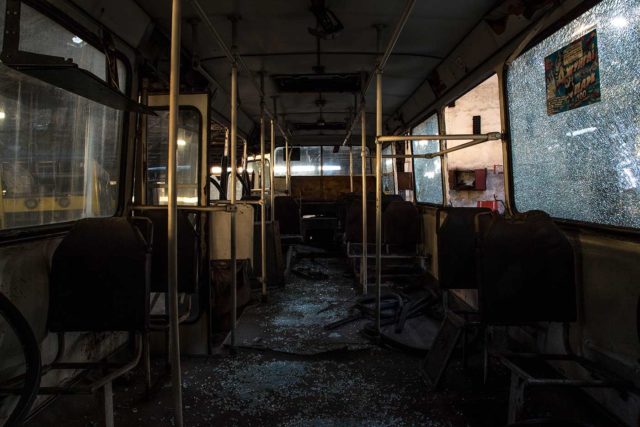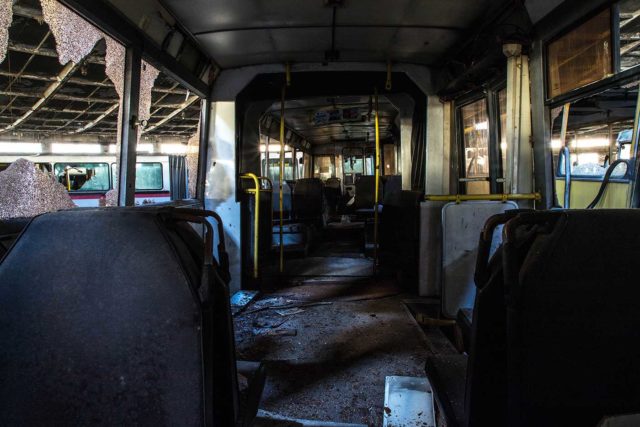Autobus Park Nº 7 in Kiev is a prime example of 1970s Soviet Modernistic design. While it has since been abandoned and fallen into disrepair, one cannot dismiss its revolutionary design and cache of disused vehicles that once ferried passengers throughout and beyond Ukraine’s borders.
Construction of a revolutionary building
Construction of Autobus Park Nº 7 began in 1973. Before it could begin, however, its designers had to figure out a way to both fit it in the compact urban area to which it had been designated and maintain the several hundred buses that were expected to call it home.


The design for the building was brought to life by V.A. Kozlov and S.I. Smorgon, the project’s chief engineers. The pair, inspired by modern circuses, came up with a design that featured a central support pillar and walls supported by steel cables. The result was a circular concrete and steel building held together by an 18-meter-high pole and 180 cables capable of supporting 350 tons.

The second issue surrounded how to make the building as cost effective as possible. This was accomplished through the use of natural light, as opposed to synthetic electricity. The concrete plates in the roof were fitted with portholes, while glass cylinders were installed along the outer wall. The latter also had the added bonus of providing insulation.

After the design elements were settled upon, chief architect V.P. Zinkevic worked with Kievsky Promstroyproekt, NIISKKISI, Ukrgiprodortrans and NIZHE to construct the depot. Construction crews were provided by the Construction and Installation Trust Nº 1 of the Ministry of Industry and Construction of the Ukrainian SSR.

The depot was considered an engineering marvel upon its completion and was the largest vehicle depot within the Soviet Union. After numerous suggestions, it was decided it would be named Autobus Park Nº 7.
An enjoyable work environment
The unique design of Autobus Park Nº 7 not only allowed for the building to be cost effective, but also an enjoyable work environment for its 1,400 employees. The circular design was more humanistic and modern, presenting the depot as not just a workspace, but a place for the community to gather.


The bright lighting worked to further cement this feeling in the minds of workers. The numerous windows allowed for the interior to enjoy endless sunlight during the day, creating an exceptionally bright work environment.
More than a garage
While Autobus Park Nº 7’s purpose was to house the 400 buses within its fleet, it was more than just a depot. It was the base of operations for buses operating in Kiev – including city and intercity buses – as well as those driving international routes to such locations as Germany, Moldova, Belarus, Russia and Poland.


The building was fully air-conditioned and featured a mechanized repair bay with conveyor belts, as well as a four-gate vehicle wash, to ensure it was able to maintain and repair buses to keep service going.

On the employee side, Autobus Park Nº 7 had within it communal canteens and a computer center, the latter of which saw the calculation of staff salaries and work shifts. It also aided in the design and optimization of bus routes in and around Kiev.


The depot saw its shining moment come in the aftermath of the Chernobyl nuclear disaster on April 26, 1986. To help evacuate residents of Pripyat, a town located near the nuclear site, the government enlisted 70 buses from Autobus Park Nº 7.


According to a former worker, some of the buses were left in the Chernobyl Exclusion Zone due to the amount of radiation they’d absorbed. Those that made it back to Kiev were decontaminated before returning to service. More information regarding the remaining buildings of Chernobyl can be found in Darmon Richter’s Chernobyl: A Stalkers’ Guide.
Fall of the Soviet Union
The beginning of the end for Autobus Park Nº 7 came with the fall of the Soviet Union in 1991. Many of its international routes were discontinued and service was gradually reduced. This was somewhat spurred by the Ukrainian economic crisis of the 1990s, which prevented funds from being allocated to repair the increasingly old fleet.

The reduction of local bus routes continued into 2005, and the depot official shut down in 2015.
Autobus Park Nº 7 today
Following its closure, Autobus Park Nº 7 has sat abandoned, becoming one of Kiev’s most problematic ruins. Nature has slowly begun to overrun the building, which remains an example of Soviet Modernism during the communist era.

South Korean boy band NCT U made headlines in 2018 when they filmed the music video for their single, “Boss,” at the bus depot and other areas of Kiev. The video has since gone on to be viewed over 159 million times.


There was an effort that same year to have the Kiev City Council turn Autobus Park Nº 7 into a public transport museum. Despite the petition receiving the required 10,000 signature, city officials remained silent. It’s speculated this is due to the controversy surrounding the preservation of Soviet heritage within Ukraine.
